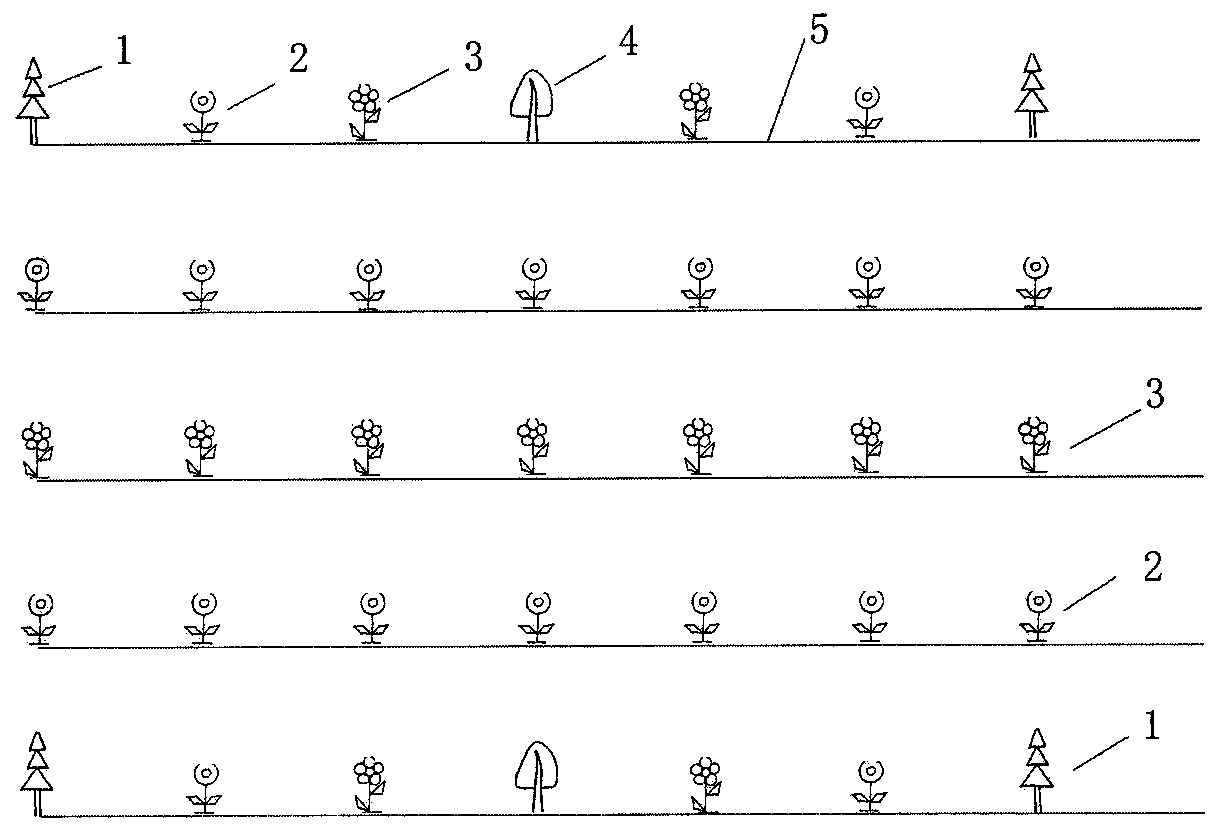A method for afforestation of secondary salinized land in arid area
A technology for secondary salinization and arid areas, applied in land preparation methods, afforestation, and botanical equipment and methods, etc., can solve problems such as difficulty in improving salinity, poor fertility in salinized land, and low plant survival rate in salinized land, etc. problems, to achieve the effect of small water consumption, meeting the needs of water, and saving ecological water
- Summary
- Abstract
- Description
- Claims
- Application Information
AI Technical Summary
Problems solved by technology
Method used
Image
Examples
Embodiment 1
[0021] In the Yingsu section of the lower reaches of the Tarim River, planted on secondary salinized land with a soil salt content of 9.30g / L and a total nitrogen content of 0.14g / L:
[0022] a, species selection: select four types of plants-arbor 1, shrub 4, halophytic herb 2 and high-quality forage 3, wherein the species of arbor 1 is Populus euphratica with 2-3 years of life, complete root system or little damage, and a base diameter of 5 cm; shrub 4 For species, choose Tamarix splendens, which is 2-3 years old, with a well-developed root system, and a base diameter of 3-5cm; for halophytic herbs, 2, choose the seeds of Salicina splendens with salt-excreting function; for high-quality grass, 3, choose the seeds of Achnatherum splendens, a gramineous herb that has a wide habitat and is easy to survive. ;
[0023]b. Species configuration mode: according to the planting sequence: 1 row of Populus euphratica in the horizontal direction - 2 rows of saline herb Achnatherum splend...
Embodiment 2
[0027] In the 34 groups of the lower reaches of the Tarim River, planted on secondary salinized land with a soil salt content of 6.58g / L and a total nitrogen content of 0.21g / L:
[0028] a, species selection: select four types of plants-arbor 1, shrub 4, halophytic herb 2 and high-quality forage 3, wherein the species of arbor 1 is selected from 2-3 years old, complete root system or little damage, and the base diameter is 5cm. 4 Species choose Haloxylon, which is 2-3 years old, with a well-developed root system and a base diameter of 3-5cm; for halophytic herbs 2, choose the seeds of Huahuachai with salt-excreting function; wheat seeds;
[0029] b. Species configuration mode: according to the planting order: horizontally, there is 1 row of arbor syringa - 2 rows of saline herb Huachai - 3 rows of high-quality pasture brome - 4 rows of shrub Haloxylon - 3 rows of high-quality pasture brome - saline herb 2 rows of Huahuachai - 1 row of Arboria sylvestris are planted alternatel...
Embodiment 3
[0033] Planted on secondary salinized land with a soil salt content of 8.65g / L and a total nitrogen content of 0.33g / L in the 33 groups of the lower reaches of the Tarim River:
[0034] a, species selection: select four types of plants-arbor 1, shrub 4, halophytic herb 2 and high-quality forage 3, wherein the arbor 1 species selects 2-3 years old, complete root system or little damage, Xinjiang poplar with a base diameter of 5cm; shrub 4 Species choose red sand that is 2-3 years old, with a well-developed root system and a base diameter of 3-5cm; halophytic herbs 2 choose the seeds of salt-excreting salt claws; high-quality grass 3 choose gramineous forages that have a wide habitat and are easy to survive Three miscanthus seeds;
[0035] b. Species configuration mode: according to the planting order: horizontally, 1 row of arbor Xinjiang poplar - 2 rows of halophytic herb, 2 rows of salt claw - 3 rows of high-quality herb Sansigma - 4 rows of shrub red sand - 3 rows of high-qu...
PUM
 Login to View More
Login to View More Abstract
Description
Claims
Application Information
 Login to View More
Login to View More - R&D
- Intellectual Property
- Life Sciences
- Materials
- Tech Scout
- Unparalleled Data Quality
- Higher Quality Content
- 60% Fewer Hallucinations
Browse by: Latest US Patents, China's latest patents, Technical Efficacy Thesaurus, Application Domain, Technology Topic, Popular Technical Reports.
© 2025 PatSnap. All rights reserved.Legal|Privacy policy|Modern Slavery Act Transparency Statement|Sitemap|About US| Contact US: help@patsnap.com

